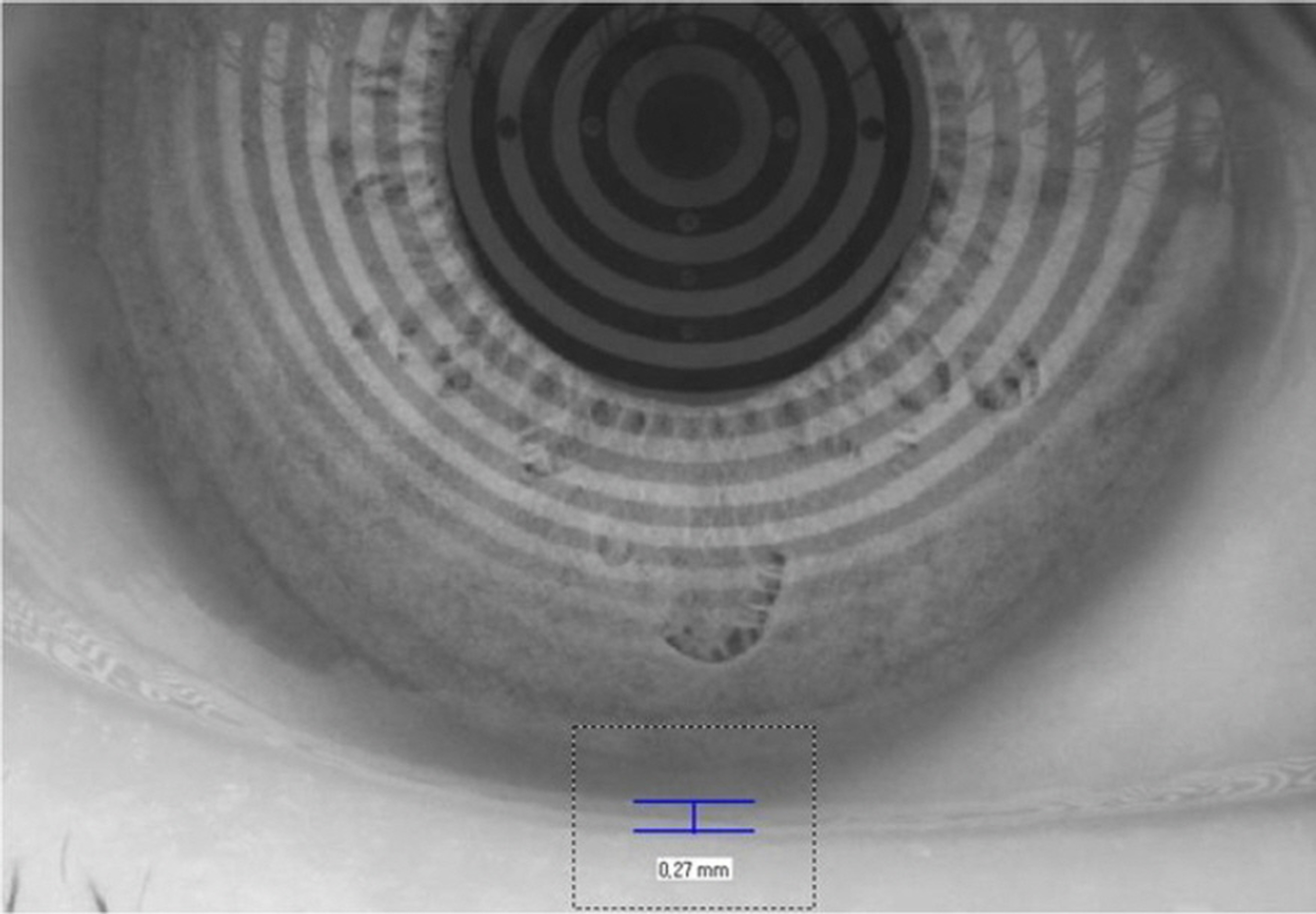J Korean Ophthalmol Soc.
2017 Apr;58(4):395-400. 10.3341/jkos.2017.58.4.395.
A Pilot Study of Changes in Tear Film Short-term Dynamics with Infrared Imaging after Phacoemulsification
- Affiliations
-
- 1Department of Ophthalmology and Visual Science, Yeouido St. Mary's Hospital, College of Medicine, The Catholic University of Korea, Seoul, Korea. sara514@catholic.ac.kr
- KMID: 2376593
- DOI: http://doi.org/10.3341/jkos.2017.58.4.395
Abstract
- PURPOSE
To evaluate the short-term changes in tear film dynamics with non-invasive infrared imaging measurement before and after cataract surgery as a pilot study.
METHODS
Seventeen eyes of 17 patients without preoperative dry eye were enrolled in this study. Non-invasive keratograph tear break-up time (NIK-TBUT) and non-invasive keratograph tear meniscus height (NIK-TMH) were measured before and 1 day, 1 week, and 1 month after cataract surgery using a keratograph.
RESULTS
The mean patient age was 64.47 ± 10.28 years, and 78.95% were female. Although the mean postoperative 1 day NIK-TBUT-first value was not significantly different from the preoperative value, the mean postoperative 1 week and 1 month NIK-TBUT-first values were significantly lower than preoperative values (p < 0.05). The postoperative 1 day, 1 week, and 1 month NIK-TBUT-average and the NIK-TMH values were not different from preoperative values.
CONCLUSIONS
Our study showed that cataract surgery can lead to tear film instability. And it is important to determine the long-term outcomes of surgery and whether NIK-TBUT and NIK-TMH correlate with slit lamp examination tear break-up time (SLE-TBUT) and slit lamp examination tear meniscus height (SLE-TMH).
Keyword
Figure
Reference
-
References
1. The definition and classification of dry eye disease: report of the definition and classification subcommittee of the international dry eye workshop . . Ocular surf. 2007; 5:75–92.2. The epidemiology of dry eye disease: report of the epidemiology subcommittee of the international dry eye workshop . . Ocular surf. 2007; 5:93–107.3. Li XM, Hu L, Hu J, Wang W. . Investigation of dry eye disease and analysis of the pathogenic factors in patients after cataract surgery. Cornea. 2007; 26:(9 Suppl 1):S16-20.
Article4. Cetinkaya S, Mestan E, Acir NO. . The course of dry eye after phacoemulsification surgery. BMC Ophthalmol. 2015; 15:68.
Article5. Cho YK, Kim MS. . Dry eye after cataract surgery and associated in-traoperative risk factors. Korean J Ophthalmol. 2009; 23:65–73.
Article6. Kasetsuwan N, Satitpitakul V, Changul T, Jariyakosol S. . Incidence and pattern of dry eye after cataract surgery. PLoS One. 2013; 8:e78657.
Article7. Cox SM, Nichols KK, Nichols JJ. . Agreement between automated and traditional measures of tear film breakup. Optom Vis Sci. 2015; 92:e257–63.
Article8. Lan W, Lin L, Yang X, Yu M. . Automatic noninvasive tear breakup time (TBUT) and conventional fluorescent TBUT. Optom Vis Sci. 2014; 91:1412–8.
Article9. Yokoi N, Komuro A. . Non-invasive methods of assessing the tear film. Exp Eye Res. 2004; 78:399–407.
Article10. Abdelfattah NS, Dastiridou A, Sadda SR, Lee OL. . Noninvasive imaging of tear film dynamics in eyes with ocular surface disease. Cornea. 2015; 34:Suppl 10:S48-52.
Article11. Nichols KK, Mitchell GL, Zadnik K. . The repeatability of clinical measurements of dry eye. Cornea. 2004; 23:272–85.
Article12. Dogru M, Ishida K, Matsumoto Y. . Strip meniscometry: a new and simple method of tear meniscus evaluation. Invest Ophthalmol Vis Sci. 2006; 47:1895–901.
Article13. Altan-Yaycioglu R, Sizmaz S, Canan H, Coban-Karatas M. . Optical coherence tomography for measuring the tear film meniscus: cor-relation with schirmer test and tear-film breakup time. Curr Eye Res. 2013; 38:736–42.
Article14. Madden RK, Paugh JR, Wang C. . Comparative study of two non-in-vasive tear film stability techniques. Curr Eye Res. 1994; 13:263–9.
Article15. Goto T, Zheng X, Okamoto S, Ohashi Y. . Tear film stability analysis system: introducing a new application for videokeratography. Cornea. 2004; 23:(8 Suppl):S65-70.16. Jiang Y, Ye H, Xu J, Lu Y. . Noninvasive keratograph assessment of tear film break-up time and location in patients with age-related cataracts and dry eye syndrome. J Int Med Res. 2014; 42:494–502.
Article17. Hong J, Sun X, Wei A. . Assessment of tear film stability in dry eye with a newly developed keratograph. Cornea. 2013; 32:716–21.
Article18. Kohlhaas M. . Corneal sensation after cataract and refractive surgery. J Cataract Refract Surg. 1998; 24:1399–409.
Article19. Ram J, Gupta A, Brar G. . Outcomes of phacoemulsification in patients with dry eye. J Cataract Refract Surg. 2002; 28:1386–9.
Article20. Oh T, Jung Y, Chang D. . Changes in the tear film and ocular surface after cataract surgery. Jpn J Ophthalmol. 2012; 56:113–8.
Article21. Khanal S, Tomlinson A, Esakowitz L. . Changes in corneal sensitivity and tear physiology after phacoemulsification. Ophthalmic Physiol Opt. 2008; 28:127–34.
Article22. Methodologies to diagnose and monitor dry eye disease: report of the definition and classification subcommittee of the international dry eye workshop . . Ocular Surf. 2007; 5:108–52.23. Kojima T, Ishida R, Dogru M. . A new noninvasive tear stabil-ity analysis system for the assessment of dry eyes. Invest Ophthalmol Vis Sci. 2004; 45:1369–74.
Article24. Mengher LS, Bron AJ, Tonge SR, Gilbert DJ. . Effect of fluorescein instillation on the pre-corneal tear film stability. Curr Eye Res. 1985; 4:9–12.
Article25. Hertzog MA. . Considerations in determining sample size for pilot studies. Res Nurs Health. 2008; 31:180–91.
Article
- Full Text Links
- Actions
-
Cited
- CITED
-
- Close
- Share
- Similar articles
-
- Influence of Vitreoretinal Surgery on Ocular Surface Dynamics Using Keratograph 5M
- Assessment of Tear Lipid Layer after Treatment by an Infrared Instrument
- Corneal Sensation and Tear Film Stability after Cataract Surgery with Temporal Clear Corneal Incision
- The Change of Corneal Sensation and Tear Film Stability after Cataract Surgery in Diabetic Patients
- The Changes in Tear Film after Primary Pterygium Operation



